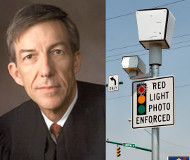11/1/2016
Florida Appellate Courts Split On Camera LegalityThree-judge appellate panel steps in to save some Florida red light camera programs, punt issue to state Supreme Court.

The courts of appeal in Florida are formally split on whether municipalities have been running red light camera programs in a way that violates state law. The Second District Court of Appeal on Friday distanced itself from Hollywood v. Arem, the decision of a sister court (view case). The conflict sets the stage for the long-standing battle to be resolved in the state Supreme Court.
"We also disagree with the Fourth District's decision in Arem to the extent it conflicts with our decision, and we certify conflict with Arem," Judge Douglas Alan Wallace wrote for the three-judge panel.
The disagreement centers on whether the private vendor American Traffic Solutions (ATS) can legally provide a turn-key automated ticketing service that controls every aspect of a photo enforcement as long as a police officer clicks the "accept" button granting ATS instant authority to mail a citation. In the Arem case, the Fourth District found that a city could not outsource the function of determining guilt to a "third-party for-profit vendor" like ATS.
ATS and the city of Oldsmar argued that ATS merely performed an administrative function by pre-screening alleged violations. The court was impressed by the fact that ATS violation processors receive "one week of training" before judging motorists. Each ATS processor reviews no fewer than 110 alleged violations per hour, meaning each click to convict is made after no more than thirty seconds of scrutiny of motor vehicle records, video, photographs or other supposed evidence. Lawyers for motorist Tammy Vo Trinh argued that even this perfunctory screening was not allowed under Florida's red light camera statute, which requires review by a law enforcement officer that amounts to more than just pressing a button. Friday's decision came to the opposite conclusion.
The three-judge panel insisted that because ATS now sends all of its raw data to the city along with its determinations of motorist guilt, the city effectively has the power to review all the evidence.
"We conclude that under the arrangement between the city and ATS, the power to determine whether a red light violation has occurred and the ultimate decision to issue a notice of violation and a uniform traffic citation remains with the city," Judge Wallace wrote. "Although ATS processors initially screen the recorded events on behalf of the city, the screening function is circumscribed by the city's business rules. Naturally, the business rules are designed to avoid wasting the traffic infraction enforcement officer's time in reviewing events that cannot be prosecuted for one reason or another or that the city has determined it does not wish to review for possible red light violations."
The judges insisted that ATS does not determine whether there is probable cause that a violation took place because the city employee does that by clicking the accept button.
"Because the traffic infraction enforcement officer makes the determination about whether probable cause for a violation exists and whether to issue a notice of violation, no unauthorized delegation of police power has occurred," Judge Wallace concluded.
A copy of the new decision is available in a 220k PDF file at the source link below.


